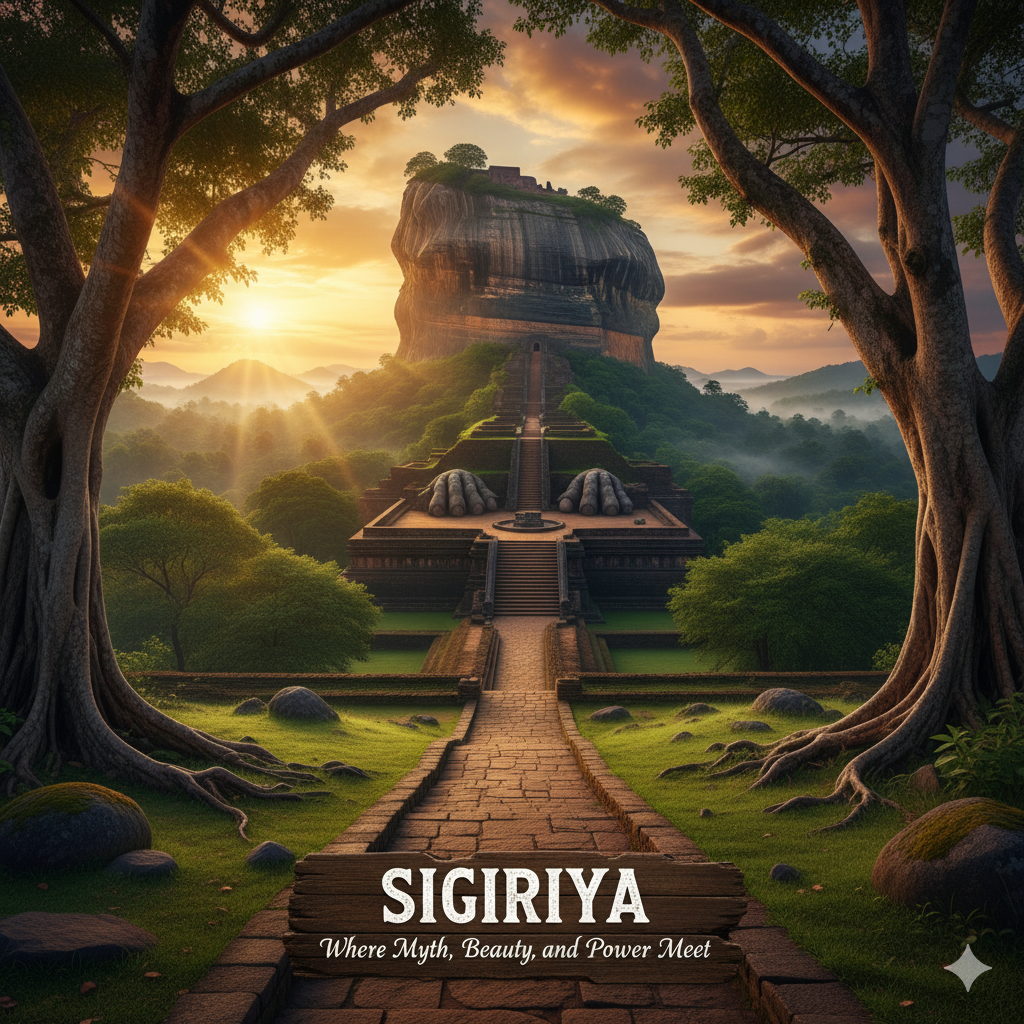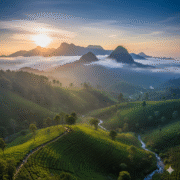
Sigiriya: Where Myth, Beauty, and Power Meet
- November 13, 2025
- eunoialankatours
- 6:30 pm
Welcome to Sigiriya, which is more than just a rock fortress. It’s a beautiful open-air theatre of history, myth, engineering, art, and poetry. In this ruined royal citadel, stories may be heard coming from every wall, garden, and stairwell. Eunoia Lanka Tours wants you to see Sigiriya not simply as a place to visit, but as a conversation with the past via a themed narrative lens.
The City of Celebration
During its golden age, Sigiriya was more than just a fortress; it was a carefully planned paradise for the rich and powerful, a royal stage where power was displayed, nature and architecture were brought together, and pleasure was planned. It was a city where art, nature, and religion came together to make a king more powerful and wow his guests. There were fancy dinners, beautiful dances, and deep conversations in pavilions that floated over water gardens and were covered by old trees.
The King as a Divine Conductor
Kasyapa was not a normal monarch. He was called a patricide and shunned by the elite in the city. At Sigiriya, he changed his image from a king to a celestial ruler who represented cosmic order. His mansion at the top of the mountain was more than simply a home; it was a metaphorical axis mundus, the hub of a city that was built to reflect the harmony of the stars. Sigiriya became his safe place, his paradise, and his stage.
The Power of Art: The Frescoes and Rūpabheda
Sigiriya is one of the few ancient structures that shows how art was used to support royal ideas. The apsara frescoes that float across the western rock face are not just pictures of beauty; they are also tools of power. These heavenly women, with their flowers, jewels, and look, bring to mind fecundity, divine favour, and courtly beauty. Whether they were Lightning Princesses or Cloud Damsels, the king’s image was raised and people wanted to worship them.
The painters of Sigiriya were experts at a classical style called Rūpabheda, which means breaking down and recreating form to show emotional nuance, individuality, and spiritual essence.
- Iconographic Significance: Rūpabheda helps us figure out the significance of icons and how the king presented himself as Kuvera, the god of prosperity, surrounded by goddesses, queens, and daughters.
- Secular Masterpiece: Sigiriya is the only spot in ancient Sri Lanka where secular paintings can be found. Most of the other ancient paintings are religious.
- Visual Clues: The women with fair skin wear see-through silk clothes and hold lotuses. The women with darker skin, who are probably attendants, wear short jackets and carry baskets of flowers. The differences in colour, clothing, stance, and accessories tell a lot about how the court worked and what art meant.
The Mirror Wall: The First Visitors Book in the World
The Mirror Wall runs below the frescoes. It used to be polished to a shine that reflected the art above and the amazement of those who came to view it. From the 6th to the 13th century, people from all across Sri Lanka wrote poems on this wall. These poems are now known as the Sigiri Graffiti.
These lines, which largely praise the painted beauties, show a lot of feeling, a high level of literary skill, and an unexpected amount of artistic sensibility. The Mirror Wall is not only a place where individuals can express themselves, but it is also a quiet testament to the literary skills of everyday people in ancient Sri Lanka. It is a treasure mine of how the Sinhala language has changed over time and a vivid picture of the social lives, feelings, and tastes of people in Sri Lanka in the Middle Ages. For more than 700 years, travelers wrote about their amazement, flirted with the muse, and saved their ideas in poem on the Mirror Wall. It may be seen as the world’s first visitors’ book.
Gardens as a Place for Fun and Ritual
It is impossible to overstate how important the gardens of Sigiriya are. The city’s landscape architecture is a complex mix of geometric and nature, power and beauty. There are three main types of gardens:
- Water Gardens: These are symmetrical and mathematically built, with island pavilions, marble fountains (which still work today), and underground pipes.
- Boulder Gardens: A layout of rock clusters that isn’t symmetrical and looks like it grew naturally. This was probably the holy center during the time of the monks at Sigiriya.
- Terraced Gardens: These gardens rise in concentric circles around the rock and are made up of walls and stairs that lead up to the Lion Staircase.
These designs served symbolic, sensory, and ceremonial purposes. Sigiriya’s gardens were more than just pretty places; they were designed to be experiences with spiritual overtones.
Reflections of Faith and Wonder in the World
Sigiriya was built with royal goals in mind, but it later returned to its original monastic atmosphere. Monks meditated in rock shelters surrounded by the decaying beauty of Kasyapa’s vision. But Sigiriya never lost its magic. People kept coming to see the beauty, not to worship gods.
- Complex Iconography: The women in the paintings are young and old, with golden or dark complexion, and wearing jewellery or simple clothes. They are both heavenly beings and real women from the court.
- “Souvenirs of Wonder”: The clay sculptures found in the ruins, which are small apsaras based on the paintings, show that the site is still very interesting. Pilgrims probably brought these “souvenirs of wonder” with them. This is an early example of cultural appreciation.
A Mythical and Memorable Living Landscape
Sigiriya is not a quiet ruin; it is full of memories. It still talks to anybody who listen, from the poems carved onto its walls to the shadows that its boulders cast.
The huge lion paws that still protect the last climb are a reminder of the legendary creator of the Sinhalese people. The throne at the top tells the story of a monarch who strove to change the future through art, building, and pretending to be a god. Sigiriya is a narrative about forgiveness, disobedience, and respect.
The Invitation from Eunoia
We at Eunoia Lanka Tours encourage you to learn about Sigiriya through storytelling. Come with us to the water gardens, where the fountains still dance. Go up the lion stairway where poets used to sigh. Stand in front of the Mirror Wall and read poems that make you feel connected to people who are no longer alive.
You shouldn’t only look at Sigiriya; you should feel it, think about it, and remember it. Our theme narrative method helps you figure out what its symbols mean, what its tales mean, and how to connect with the feelings that are carved into its stone.
Come with us to Sigiriya, where every step has a story to tell.


